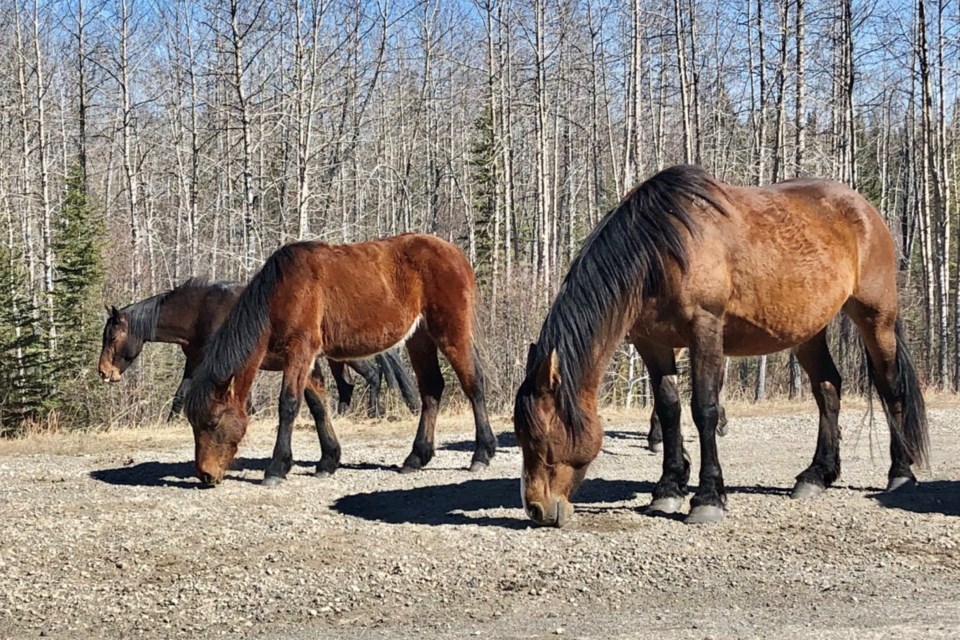SUNDRE - The new provincial feral horse management framework may prove to be a worthwhile step in the protection and promotion of the free-roaming animals, including more than 900 west of Sundre, according to Bob Henderson, director and government liaison with the Olds-based Wild Horses of Alberta Society (WHOAS).
“We have been calling on the provincial government to come up with a management strategy for the horses,” Henderson told the Albertan. “We want the government to come up with some sort of plan or strategy to manage the horses properly, effectively and humanely.
“This is a start when they are showing they have some sort of idea when they want to go and how they want to go about it. It’s taken a long time to get there, but at least it’s a start.
“What they have done is recognize the horses as being an integral part of the landscape and ecosystems. So now accept them and try to come up with a management plan to show what affect the horses are having.”
Released Sept. 25, the new framework will “ensure the future sustainability of the horses while addressing significant challenges to the long-term sustainability of the ecosystem because of the number of horses on the landscape,” said Todd Loewen, minister of Alberta Forestry and Parks.
“While past efforts to inform and engage Albertans on feral horses were unsuccessful, our management framework outlines clear, simple and honest efforts that we hope will resonate with Albertans and ensure we maintain the sustainability of the landscape where feral horses live.”
Without a framework in place, feral horses can negatively affect wildlife, birds, fish, cattle and vegetation in the areas where the horses live, he said.
The framework was developed with input from the multi-stakeholder Feral Horse Advisory Committee, which included ranchers, oil and gas representatives and WHOAS members.
There are six equine management zones in the province: Brazeau, Nordegg, Clearwater, Sundre, Ghost River and Elbow.
A recent government ‘minimum count’ of feral horses in the province found 969 in the Sundre zone, 311 in Ghost River, 97 in Clearwater, 33 in Nordegg, 18 in Brazeau, and an estimate of 84 in Elbow.
For his part, Henderson says he does not believe the feral horses are causing undue damage to the landscape where they live.
“The horses aren’t the one responsible for most of the damage and the environmental impact and the changes that are happening in the foothills,” Henderson said. “It’s caused by overgrazing (by livestock) and the logging.
“If you go out west (of Sundre) you wouldn’t believe the clear cutting that is continuing to happen out there. Not that it is wrong, but it is definitely having a big impact on wildlife especially. The deer and the elks and the bears and all that are being chased out of their normal habitat and it’s not the horses’ fault.”
Jason Nixon is the MLA for Rimbey-Rocky Mountain House-Sundre.
“Alberta’s new feral management framework is essential to protect biodiversity and our province’s wildlife,” Nixon, whose riding includes the equine management zone west of Sundre, told the Albertan.
“I am confident that the new management framework will do its intended job protecting the Eastern Slopes.”
According to the 44-page framework document released Sept. 25, strategies will guide actions towards achieving the vision and objectives of the management framework, including:
• Utilize ecosystem-based indicators and thresholds to ensure a sustainable multi-use landscape.
• Integrate science with Indigenous knowledge and practices pertaining to feral horse management in the Eastern Slopes.
• Ensure monitoring and reporting of feral horse population.
• Utilize adaptive management to ensure feral horse populations align with landscape capacity.
The framework establishes status classification thresholds, which includes horse populations, to guide when management actions are required.
Threshold 1 (sustainable to concerned tiers) is based on the amount of the available allocatable forage that is not allocated by permit to livestock or reserved for ecosystem processes and multiple use. This remaining amount of forage could be grazed by feral horses without impairing the core rangeland functions of plant communities, forage allocated to livestock, the maintenance of biodiversity and wildlife, or the potential for multi-use and recreation.
Feral horse populations below this threshold will be considered ecologically sustainable and not requiring active management.
Threshold 2 (concerned to unsustainable tiers) represents a population cap for the feral horse populations. Active management is employed. Population levels of horses approaching or at Threshold 2 are managed through actions like adoption, contraception or other programs that help maintain or reduce the herd size.
Threshold 2 is based on feral horse populations, assessment of ecological health, wildlife populations and forage utilization. If one or more of more of these indicators trend in a negative direction, additional management actions would be necessary through a licensed capture and removal of horses from the zone.
In the case of the Sundre zone,Threshold 1's minimum population has been set at 628. With the zone's minimum population already at 969, Threshold 1 has already been triggered. The horse population trigger for Threshold 2 in the Sundre zone is 1,000.
Meanwhile, Henderson said WHOAS would like see the province’s feral horses given a unique name such as the Alberta Mountain Horse.
“I think if you designate them as a distinct species, not wildlife, you could have a more effective management plan in the future.
The compete feral horse management framework is available on the provincial government website.
- With files from Lea Smaldon



